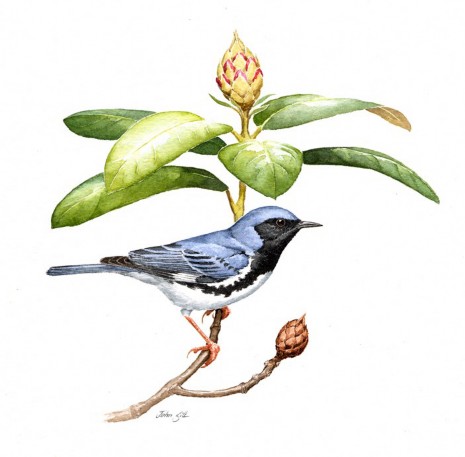Black-throated Blue Warbler by John Sill

John Sill is a freelance wildlife artist living in the mountains of North Carolina. He was the illustrator for the Bird Identification Calendar for Mass Audubon for many years. His work has appeared in Birds In Art at the Leigh Yawkey Woodson Art Museum, Wausau, Wisconsin, and in Art of the Animal Kingdom at the Bennington Center for the Arts in Vermont. He continues to illustrate the “About” and “About Habitats” series of natural history books for children written by his wife Cathryn.
Black-throated Blue Warbler
The Black-throated Blue Warbler (Setophaga caerulescens) is so strikingly sexually dimorphic in plumage that both Alexander Wilson and John James Audubon considered the sexes as separate species. The male is stunning: white below, dark blue above, with a black face and flanks, and an obvious white wing patch. In contrast, the female is drab olive with pale undertail coverts and a darkish cheek outlined above and below with lighter olive. Most adult females have a white wing patch, which is missing in the otherwise similarly plumaged juvenile females. Male Black-throated Blue Warblers do not molt into a “confusing fall warbler” plumage and thus look much the same year round. Two subspecies have traditionally been accepted although recent studies possibly suggest otherwise.
Black-throated Blue Warblers breed across the eastern half of southern Canada through Nova Scotia, and in the United States from the Great Lakes through New York State to New England away from the coast. South of the Northeast, they breed in a band that cuts through the Appalachian Mountains to northern Georgia. The species is migratory and winters in the Greater Antilles, the Bahamas, and the Caribbean, and in coastal areas from the Yucatan Peninsula through Honduras, mostly in dense tropical woodlands and forest. In Massachusetts, Black-throated Blue Warblers are a fairly common breeder Worcester County westward. They are an uncommon to fairly common migrant in both spring and fall. During migration they often are encountered in mixed species flocks.
Usually Black-throated Blue Warblers are seasonally monogamous but occasionally are polygynous. They may produce two broods in a season. They tend to be faithful to their breeding sites and sometimes pairs may reunite for a second breeding season. Not much is known about courtship behavior. Males have been observed in protracted chases of females, and males and females perched together have been observed assuming a posture with heads up, bills open, and wings drooping. Mate guarding by the males is common after pair formation. In winter both sexes are solitary and defend a feeding territory; they also tend to be faithful to their winter sites.
Males do most of the singing; their characteristic song typically consisting of a series of zee notes with the last note longer and slurred. Song serves both as territorial advertisement and a way to attract females. Counter-singing males at territorial boundaries give a two-note song and a three-to-five note whistle. During chases or fights, males also will produce a rapid trill. Both males and females aggressively defend their territory. During territorial disputes the male approaches an intruder on a fluttering glide while emitting the fast trill call. On the ground, males posture with head forward and wings drooping, and they may initiate a chase that can last for several minutes. Fights may result with the pursuer forcing the chased individual to the ground and pummeling it with his wings. Fighting birds may even lock claws and flutter into the air. Territorial disputes may last for hours.
Black-throated Blue Warblers nest in large tracts of deciduous or mixed deciduous-conifer forest with dense shrub layers, often in mountainous areas. It is thought that the female chooses the nest site, although the male may accompany her while she searches. The nest is usually in a fork of a dense shrub, three to five feet from the ground. The female constructs the nest, which is a cup of bark strips held together with spider web silk and possibly saliva; it is well hidden in the leaves. Only the female develops a brood patch and she alone incubates the usual clutch of four creamy-white eggs, spotted with various colors, for the 13 days until hatching. The male may bring food to the female while she is incubating. The chicks at hatching are altricial—nearly naked, eyes closed, and helpless. Both parents mob predators near the nest and the female may give a distraction display that includes a high-pitched twitter. The female broods the young birds for the eight to ten days until fledging. Both parents bring small insects to the chicks and continue to feed them for two to three weeks until they are independent. The male may take over all of the feeding duties if the female begins a second nesting.
Black-throated Blue Warblers are insectivorous, taking small insects, spiders, flies, and larvae, but they also may eat some small fruits in winter. They are visual foragers, snatching insects or hover-snatching them mostly from the undersides of leaves. They also glean foliage, twigs, and branches, especially in shrubs in the middle and lower strata of trees. Males forage, on average, higher off the ground than females. Some evidence further suggests that they may glean more in forests and hover less while on the wintering grounds.
During migration, many Black-throated Blue Warblers die in collisions with communication towers and buildings, while cold and rain may cause the death of nestlings. However, because Black-throated Blue Warblers tend to breed in extensive tracts of forest, they suffer little from cowbird parasitism. Because of their fidelity to their winter sites, they are vulnerable to deforestation or habitat degradation on their wintering grounds. Black-throated Blue Warbler populations probably underwent a steep decline in the 18th and 19th centuries due to deforestation, but they have rebounded with the return of farmland to forest. Breeding Bird Survey data suggest that population numbers are stable or increasing, so this lovely little warbler appears to be secure.
William E. Davis, Jr.